 Many people in our area are not covered by dental insurance. Several times a month, we hear patients wondering if they should buy dental insurance coverage before they proceed with their dental work. This article will help you understand how dental insurance coverage works, and in what situations it can benefit you. We all know that insurance companies have developed a reputation for putting themselves before their customers. In reality, the customer for a dental insurance company is the employer who purchases a group insurance plan. With the pressures on business from the high costs of medical insurance, dental insurance plans have suffered badly for several years. In addition, more employers are offering dental insurance to their employees only if the employee pays for all or part of the premium. So when is dental insurance advantageous? Dental insurance is probably an excellent help if your employer covers the premium completely. However, unlike medical insurance, most dental insurance plans only cover a maximum of $1,000 per year. You may find it interesting that when the first dental insurance plans were offered around 1960, the average annual benefit was … $1,000 a year. So accounting for inflation since 1960, today’s plans over less than $150 in 1960 dollars. For patients that come into our office with more expensive problems, I like to tell my patients to consider their dental insurance as a $1,000 off coupon, rather than dental “insurance.” But let’s say you have to pay for part or all of your insurance premium, or your employer doesn’t offer dental insurance and you are thinking about purchasing an individual plan. For the insurance company to make a profit, they must charge enough premiums to cover your dental work, plus administrative fees, plus their profit. If you must pay all of the premiums on your own, this makes it unlikely you can come out ahead. If your employer pays for part of your benefits, the dental insurance might still be beneficial, but you’ll have to do some calculations. Take some time to calculate how much you’ll pay in benefits per year, and compare that amount to the cost of your “two free cleanings and exams.” In addition, if you are enrolling for the first time, you may have a waiting period before major work is completed, so that you’ve paid more insurance premiums before getting to enjoy many of the benefits of the plan. See also, Dr. Moorhead's aticle about the benefits of Health Savings Accounts that can provide tax-deductible benefits to pay for medical and dental expenses. In addition, don’t forget that our office offers extended payment arrangements using several outside firms, so that your dentistry can be handled affordably.
0 Comments
In 2003, Congress created a help for medical and dental bills that is a tremendous tax savings, but five years later, very few people know about them. A Health Savings Account (HSA) is a special tax-free savings account that is available to people who purchase high-deductible insurance plans. To qualify, your insurance plan must have a deductible of $1,300 for a self-only coverage plan, or $2,600 for a family coverage plan.
With a Health Savings Account plan, you’ll save significant amounts of money annually on taxes, health insurance premiums and retirement savings all at the same time. All of this can be accomplished without decreasing your real insurance protection or choices of doctors & specialists. High deductible medical insurance plans are offered by almost all major carriers, and their monthly insurance premiums are usually less than one-half of standard plans. They begin offering benefits once the $1,000 deductible is met. The coverage of the plans vary, but they all have catastrophic care. By placing the money that you save on insurance premiums in the HSA, you save to meet your deductible, and if your medical expenses for the year aren’t enough to meet the deductible, the money stays in your account – to cover medical expenses you want. Like an IRA, the money can rollover at year end and earn tax-free interest. An individual can contribute up to $3,350 in 2016; a family can contribute $6,750. If someone in the family is 55 or older, those amounts can be increased by an additional $1,000. You can use money placed in your HSA for medical bills, dental work for your entire family, eye care and a host of other eligible medical expenses. Questions and Observations That Will Help You Choose a Dentist
Many situations can occur that may require finding a new dentist, such as moving, having a dentist retire, or needing special services your present dentist can’t provide. Although we all know that proper dental care is vital to good health, most of us don’t know how to choose a good dentist. It can be difficult to know what questions to ask and what things to observe in the process of choosing a good dentist. You will want to know both how the dentist treats you as a person and how he treats your mouth. Following are some key questions to ask and observations to make in the process of making your choice. QUESTIONS TO ASK YOUR PROSPECTIVE DENTIST
Some things can only be learned by observation or by asking former or present patients for their opinions. Here are some things that are important to learn:
Of the three ways you can lose teeth, periodontal disease – also referred to gum disease or gum and bone disease – causes the most tooth loss in adults. Periodontal disease is a silent disease until it reaches advances stages, so without a routine dental exam, you could have it but not know it. Of the half of adult’s that don’t go to the dentist regularly, 80% have serious periodontal disease by age 40. The word “periodontal” describes the structures around that tooth that give it support – the gingival (gums), the bone, and the fibers in-between. Signs that show you may have periodontal disease include:
First, let’s take a look at the stages of periodontal disease. This first photo shows an example of healthy gums. The gingival is light pink and flat, and the diagram shows the bone in-between teeth with proper support. Gingivitis is the first stage periodontal disease. Shown in the next photo, gingivitis is a completely reversible disease. The gums are red and swollen, but there is no damage to the bone support. In this third photo, an early stage of periodontitis is shown. You can see the gums pulling away from the teeth as they are losing their bone support. The teeth are sometimes more sensitive where the roots are partially exposed, but often there are no symptoms even at this stage of the disease. Symptoms usually don’t develop until severe bone involvement, so shown here, when the teeth become loose and sore. By this time, it’s often too late to save the involved teeth. To check the health of your gums, your dentist gently slides a measuring probe under your gums. Measurements are made several places around each tooth to show where the gums attach to your tooth, and if there is any bleeding or pus present. If the periodontal support around your tooth is in good shape, the farthest that the probe should be able to measure is 3 mm, or 1/8 inch. This is the farthest that a toothbrush and floss can clean under the gums adequately. A measurement of 4mm or greater demonstrates evidence of periodontal disease. Dentists refer to these areas as “periodontal pockets.” Other signs of periodontal disease include bleeding gums and receding gums.
The actual cause of periodontal disease is bacteria that live in these periodontal pockets. In areas this far below the gums, a breeding ground develops for particular types of bacteria called anaerobes, a type of bacteria that thrives where there is no oxygen. These bacteria release toxins that slowly cause destruction of the bone and periodontal fibers that support your teeth. Periodontal disease can be treated if it is caught early enough. Much like a patient with high blood pressure, a patient with periodontal disease cannot be completely “healed” from the damage that has already been caused, but the disease can be controlled so that further damage doesn’t occur. Treatment for periodontal disease will be covered next week. If you’re concerned you may have periodontal disease, why not call us today to schedule an examination. Click here to learn about a special offer for our web readers. You can reach us at Flemingsburg Dental Care at 888-733-3163 As mentioned in the previous article, periodontal disease is the number one cause of tooth loss in adults. Periodontal disease, or so called “gum and bone disease” acts much like termites on the foundation of your house. And like termites, the disease is silent until it is very advanced. Below are photos of one of our patients before and after periodontal treatment. In the left photo, notice the swollen, red gums and the thick tartar on the teeth. When she first came to our office, this patient had periodontal pockets that extended up to 6 mm (1/4”) under the edge of her gums. In addition to improving her appearance, her breath also dramatically improved.
Bacteria thrive in the deep periodontal pockets. The bacteria and its by-products create plaque, and the plaque eventually absorbs calcium from the mouth to form calculus, or in lay terms, tartar. Calculus leaves a very rough surface on the root of the tooth, and even allows the bacteria to imbed itself onto the root surface. Treatment for periodontal disease is primarily aimed at removing the bacteria that cause the disease. One of the primary treatments for periodontal disease is root planing, where the hard deposits of calculus are removed from the root surface, then the root surface is smoothed to remove infected tooth structure. Unlike an ordinary cleaning appointment, root planing is performed in a very detailed fashion under the gums. Root planing can be done comfortably, either by numbing the treated area, or with a product called “Oraqix” that delivers topical anesthetic gel gently into the periodontal pockets to numb the gums without injections. To keep patients even more comfortable, we recommend they take a non-steroidal medication like Advil or Aleve before the root planing, which results in a dramatic decrease in inflammation and discomfort from the procedure. Our office is one of a few in the United States that has ozonated water available to aid in treatment during root planning. In it’s July 2008 edition, the Journal of Contemporary Dental Practice stated that “ozonated water strongly inhibited the formation of dental plaque…(showing that) ozonated water is useful in reducing infections caused by microorganisms present in dental plaque.” Improved home care is also a must in treating periodontal disease. Different tooth brushing techniques are taught to provide additional gentle massage for the infected gums, and daily use of floss or floss substitutes also greatly improve healing. When periodontal pockets are especially deep, a referral to a periodontist, a specialist in gum surgery, may be needed to improve the chances of saving teeth. Because your toothbrush and floss cannot reach further than 3mm (1/8”) below the gums, patients with periodontal disease usually require more frequent cleanings. Only a dental professional can reach these deep areas. By allowing your dental hygienist to perform this gentle cleaning every three months, harmful bacteria are disturbed before they can cause additional damage. If you’re concerned you may have periodontal disease, call us today to schedule an examination. Click here to learn about a special offer for our web readers. You can reach us at Flemingsburg Dental Care at 888-733-3163 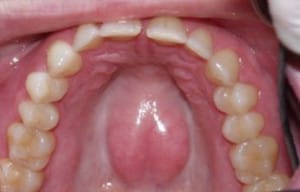 In hard palate. In hard palate. In about five percent of patients, bony growths are found that are normal variants. An exostosis is a thickening of bone around the teeth. A torus (plural tori) is a larger area of bone, and can appear in two forms: - Found on the middle of the hard palate (first picture) 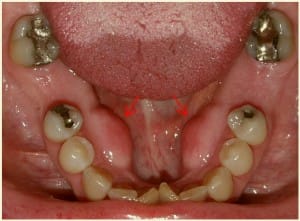 On the gums, by tongue On the gums, by tongue - Or, on the gums adjacent to the tongue. (second picture) These bony growths appear to have a genetic link, but environmental situations tend to make them larger. Bruxism (tooth grinding) and ice chewing especially seem to make them worse. Exostoses, the growths directly adjacent to the teeth, can make it more difficult to keep the teeth clean, since the bone’s overgrowth makes it more difficult to position a toothbrush and floss properly around the teeth for good home care. Tori are generally not a problem, except when a removable prosthesis, such as a partial denture or complete denture has to be fabricated. Tori can cause these problems with a prosthesis:
For these reasons, it is especially important for patients that have tori to keep their teeth and gums in excellent shape. Many people have had tori most of their life with no problem, and just assumed everyone had the same thing! In cases where tori or exostoses are in the way for a prosthesis, a minor surgical procedure is used to remove them so that the complete denture or partial denture can be fabricated without problems. Mandibular tori and exostoses can be removed by most general dentists, while a palatal torus is often referred to an oral surgeon when a complete denture is needed. It is also possible to have a bony growth that doesn’t belong there. Cancers called osteomas and sarcomas can form cause unusual bone growth in the mouth. In virtually all cases, these growths lack symmetry, growing on just one side of the mouth or notably large on one side than the other. |
Articles
All
AuthorDr. Moorhead and his team write about dental news, and answer patient questions. Archives |

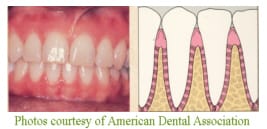
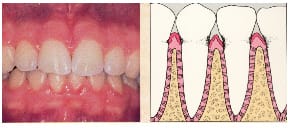
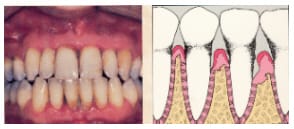
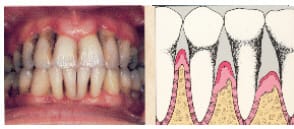

 RSS Feed
RSS Feed